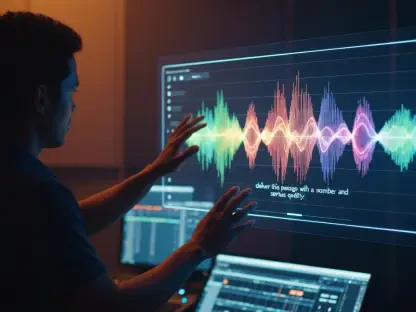In an era where laptops are expected to handle everything from intensive 3D rendering to seamless AI integration, Apple’s latest 14-inch MacBook Pro with the M5 processor has sparked intense discussion across the tech community, reflecting a growing demand for high-performance devices. Reports indicate that laptop performance demands have surged by over 30% in recent years, driven by professionals and creators needing devices that can keep up with complex workloads. This roundup dives into a collection of opinions, reviews, and insights from various industry voices to assess whether this new device truly sets a benchmark for computing or if it’s simply another incremental update in a crowded market. The purpose here is to synthesize diverse perspectives on its performance, design, and broader impact, offering a comprehensive look at what this MacBook Pro means for users and the tech landscape.
Cutting-Edge Performance: A Consensus on Power
A recurring theme among tech analysts is the M5 processor’s staggering capabilities, often described as a leap forward in laptop performance. Benchmark scores, such as Geekbench 6 results showing a single-core score of 4,250 and a multi-core score of 17,819, are frequently cited as evidence of its dominance over competitors like the Snapdragon X Elite and Intel Core Ultra 7. Many reviewers highlight how these numbers translate to real-world efficiency, making tasks like video editing and data modeling remarkably smooth.
However, not all opinions align on the necessity of such power. Some industry observers argue that while the performance is impressive, it may cater primarily to a niche of high-end professionals rather than the average user. This perspective raises questions about whether the typical consumer, focused on basic productivity or streaming, benefits from these advancements or if the cost outweighs the practical value for them.
A balanced view emerges from comparisons with other devices, where the M5’s energy efficiency stands out as much as its raw speed. Commentators note that the chip’s low power consumption during intensive tasks positions it as a sustainable choice in an age of growing energy concerns, potentially appealing to a broader audience beyond just power users.
Design Innovation: Future-Forward or Over-Engineered?
The design of the MacBook Pro garners praise for its forward-thinking approach, particularly its on-device AI capabilities and tight integration with the Apple ecosystem. Many tech blogs commend how these features anticipate user needs, enabling seamless workflows across devices and supporting complex tasks like multimedia creation with ease. This is often seen as a glimpse into the future of personal computing.
Contrasting opinions surface regarding the risk of over-engineering. A segment of reviewers suggests that while the design excels for professionals handling 3D rendering or large-scale projects, casual users might find many features redundant. The concern here is whether Apple has prioritized cutting-edge technology at the expense of accessibility for everyday consumers who may not need such advanced tools.
Another angle focuses on the competitive edge this design provides. Analysts point out that few rivals match the level of ecosystem synergy and energy-efficient AI processing found in this laptop, potentially forcing other brands to rethink their strategies. This sparks debate on whether Apple’s approach will redefine industry standards or remain a unique, isolated strength.
Display and MultimediA Professional’s Dream?
The Liquid Retina XDR display receives near-universal acclaim for its color accuracy, often highlighted as a game-changer for fields like film production and graphic design. Industry feedback emphasizes how this feature, combined with a 12-megapixel Center Stage Camera and a six-speaker sound system, elevates the device to a professional-grade tool, ideal for remote work and creative output.
Some critiques, however, question the accessibility of these high-end multimedia features in terms of cost. A few voices argue that while the display and audio quality are benchmarks, they come at a premium that might not justify the investment for users outside creative industries. This perspective challenges the notion that such specs are becoming essential across all user groups.
A broader take considers the global impact of these features, with reviewers noting their relevance in an increasingly visual and virtual work environment. The consensus leans toward viewing high-quality displays and multimedia tools as no longer a luxury but a growing necessity, especially as remote collaboration continues to shape professional landscapes.
Sustainability Efforts: Leading or Lagging?
Apple’s commitment to sustainability, including the use of 45% recycled materials in the MacBook Pro, draws significant attention. Many environmental advocates and tech commentators applaud this move, seeing it as a step toward ethical manufacturing that could influence consumer expectations over the next decade. The focus on recycled aluminum and cobalt in batteries is often cited as a standout effort.
Skeptics, though, point out that Apple’s initiatives, while commendable, are not unique in the industry, with other brands also adopting similar practices. Some opinions suggest that the pace of change might not be aggressive enough to address urgent environmental challenges, questioning whether these efforts are truly transformative or merely incremental.
A middle ground emerges in discussions about long-term impact. Analysts speculate that Apple’s visibility could pressure competitors to accelerate their sustainability goals, potentially creating a ripple effect. This debate underscores a larger conversation about balancing innovation with responsibility in tech manufacturing.
Practical Advice: Who Should Buy This Device?
Insights on the target audience for this laptop reveal a clear divide. Many reviewers agree that professionals with demanding workloads—such as video editors, developers, and designers—stand to gain the most from its capabilities. Recommendations often include leveraging Apple’s ecosystem benefits, like seamless device integration, to maximize productivity.
For casual users, the advice differs significantly, with several sources suggesting that a less powerful option like the MacBook Air might suffice. This viewpoint stresses the importance of aligning purchase decisions with actual needs rather than being swayed by cutting-edge specs that may go underutilized.
Additional tips focus on long-term value, with commentators urging potential buyers to consider resale value and durability as part of their investment. The suggestion to explore Apple’s training resources or device management tools also surfaces as a way to fully capitalize on the purchase, especially for business users transitioning from other platforms.
Reflecting on a Milestone in Computing
Looking back, the discussions surrounding Apple’s 14-inch M5 MacBook Pro paint a picture of a device that pushes boundaries in performance, design, and sustainability, while sparking debates on accessibility and necessity. The roundup of opinions reveals a consensus on its technical excellence but highlights varied perspectives on its relevance to different user groups. For those eager to explore further, delving into detailed benchmark analyses or sustainability reports from tech platforms could provide deeper context. Additionally, comparing user reviews across professional and casual segments might offer personalized insights into making an informed decision. As the tech industry continues to evolve, staying updated on how competitors respond to this benchmark will be crucial for understanding the future direction of laptop innovation.









